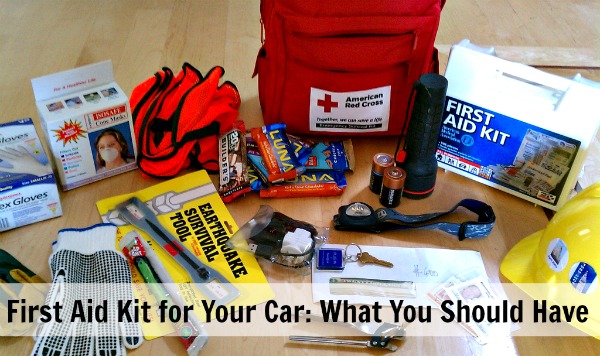We spend a lot of time in the car. Between running the kids all over and road trips, we practically live in the car. Most people do. Because Emergencies happen anywhere at anytime, it is important to have a first aid kit in your car. You can buy a first aid kit that is already put together for you, but sometimes it is better to assemble one yourself to make sure that you have everything in it that you need. Your family might have specific needs that are not covered by a traditional first aid kit. Also, for some people, you might not need everything that comes in the premade kits.
So let’s break it down! The steps that you need to get together the perfect first aid kit are as follows:
1 – Purchase the container that will be housing your first aid items. It doesn’t have to be anything fancy. Make sure that this is something that is easily seen into to get items easily. In an emergency you don’t want to have to search too much for the items you need. Reminder that choosing a bag or container that is waterproof is better than not.
2 – Remember the basics when packing your kit, as well as packing those items that are specific to your family’s needs. If you have children, make sure you are thinking of them specifically, like having things like children’s pain reliever (and not just adult), baby wipes, and ways to administer these medications if you have to on the go. These are things that you might not think of right away. There are a lot of lists out there, but the Red Cross has the most trusted list. This list is for a family of four:
- 2 absorbent compress dressings (5 x 9 inches)
- 25 adhesive bandages (assorted sizes)
- 1 adhesive cloth tape (10 yards x 1 inch)
- 1 roller bandage (3 inches wide)
- 1 roller bandage (4 inches wide)
- 5 sterile gauze pads (3 x 3 inches)
- 5 sterile gauze pads (4 x 4 inches)
- 5 antibiotic ointment packets (approximately 1 gram)
- 5 antiseptic wipe packets
- 2 packets of aspirin (81 mg each)
- 1 instant cold compress
- 2 pair of nonlatex gloves (size: large)
- 2 hydrocortisone ointment packets (approximately 1 gram each)
- Scissors
- Oral thermometer (non-mercury/nonglass)
- 2 triangular bandages
- Tweezers
- 1 blanket (space blanket)
- 1 breathing barrier (with one-way valve)
- First aid instruction booklet
I always make sure that I have an old cell phone in my kit. I make sure it is charged and turned off. It doesn’t need to have cell service, it just needs to be in working order and charged. Any phone that still technically works is capable of calling 911.
3 – Other items to consider: hot/cold packs, gloves, disposable mask, anti-diarrheal medicines, eye wash and even plastic bags. Plastic bags are do you can dispose of things that are unhygienic in a proper way.
4 – Like the Red Cross suggests, have a first aid manual in the kit. There might be injuries you don’t know exactly what to do for, and the book will be able to help.
5 – Something a lot of kit do not include is flares and items to help you if you are stranded. This is where the cell phone for calling help comes in handy. Have on hand a flashlight with extra batteries, bottles of drinking water, a blanket, and trash bags.
6 – Snacks such as crackers or granola bars and juice boxes, and a few other non-perishable foods in case you end up stranded on the road for an extended length of time are another valuable lifeline to have when going on a trip.
It is important to always be ready for any situation that you may come across. No one wants to be dealing with an injury or be stranded and not have the things needed to make everything ok. Be sure to restock your first aid kit if you have to use something from it.
The people at Brown Daub want to make sure your are prepared for any situation including purchasing your next car.

Leave a Reply